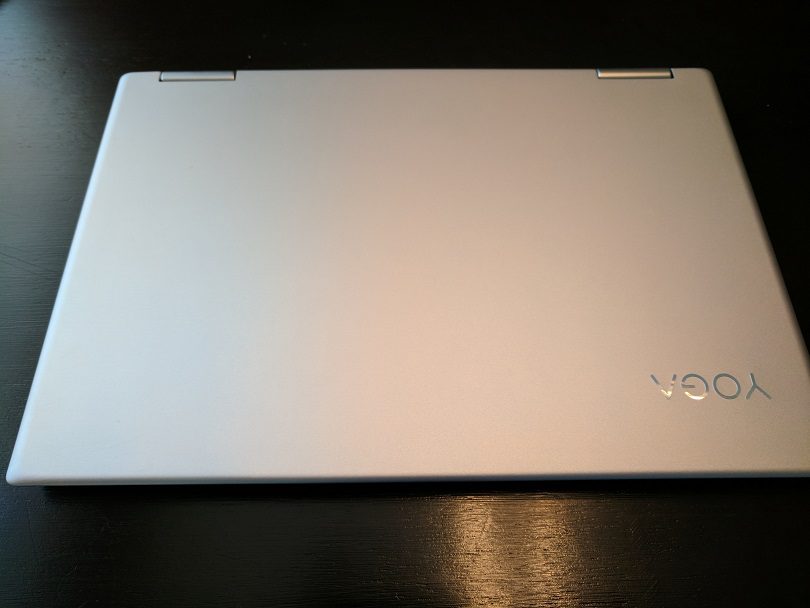Thanks to Lenovo for providing GWW with this review unit.
The Yoga 720 has the right size, power, battery life and build quality to earn the starting position in my kit. This is the first time in years I’ve been sent a review unit with a Core i5 CPU – I assumed it was a Core i7 until I ran the spec check so I could populate that section of this post. I didn’t even notice the “Core i5″ sticker on the left palm rest next to the trackpad. This 2-in-1 device has a sharp 13” screen, a comfortable backlit keyboard, and an excellently built chassis. I’m absolutely smitten with it. I’ve ran it through my usual paces: moderate Microsoft Office use, several 2-6 hour flights, small to large audience presentations, and lap use on the couch while the kids shift from playing on their own to climbing on my lap. For this lifestyle a laptop needs to be the right size with a backlit keyboard and plenty of screen real estate without compromise it’s compact nature. While Lenovo pioneered 2-in-1 laptops, it’s Dell we all have to thank for driving bezel size down. The idea of a 2-in-1 is flexibility. It provides the user with more ways to get value from thier laptop. But thick bezels have always forced laptops to be larger than necessary. The Yoga 720 is a fantastic laptop at a fantastic price.
Specifications
- CPU: 7th Generation Core i5-7200U (2.5 GHz 3MB Cache)
- Display: 13.3″ FHD IPS Anti-Glare (1920×1080)
- RAM: 8GB DDR4 2133 MHz
- SSD: 256GB PCIe
- GPU: Intel HD Graphics 620
- Battery: 4 Cell 48 Watt Hour Li-Cylindrical
- I/O: two USB-C ports, one USB-A, headphone jack
Build Quality
You’re going to love the way this feels. Lately I’ve asked myself “how small and light is too small and light?” At 2.9 pounds and 0.6 inches thick, the Yoga 720 feels great. There are smaller laptops available with the same specs, but I’m not sure they’re worth the extra dough. Typically, any smaller than the Yoga 720 and you’ll experience flex. The latest phenomena to plague the ultrabook market. Even with outstanding materials, smaller ultrabooks will bend as you type or lift the screen. Props to Lenovo on finding a good balance. The chassis of the Yoga 720 is silver, with no other options available. The hinges are spaced towards the ends of the device, giving it more stability while typing.
The display is 1080p, and unlike the recently reviewed Lenovo ThinkPad Carbon X1, it’s actually really nice and befitting a 13.3″ screen. The 165 ppi is just fine here. The side bezels are pretty thin, and Lenovo put the webcam on the top, which gives the top a thicker bezel than the sides and bottom. Lenovo could have thinned the bottom bezel to drop the display down but they’d have to remove the function key row, which is helpful to have on an ultrabook for quick access to volume control, airplane mode and brightness. When the Yoga 720 is folded into tablet mode, the only way to access those controls is with Windows 10’s touch controls. Two more comment about size: I’m a fan of fingerprint sensors and large trackpads. The Yoga 720 has the sensor and a medium-sized trackpad.
While most ultrabooks are moving to a USB-C model only, Lenovo included two of them and a classic USB-A port, which is essential for legacy devices such as a wireless mouse, presenter stick, and connected devices like my recently acquired fitbit Ionic. I have been carrying around a USB-C hub so I can connect multiple devices via USB-A, as well as an external monitor via HDMI. These are the compromises of new ultrabooks. Thankfully USB-C is lightning fast.
The Yoga 720 has JBL stereo speakers with Dolby Premium Audio. The speakers are at the bottom, which isn’t ideal. But when you flip the device into tent mode the speakers point right at you. I’ve used tent mode on a plane but otherwise I don’t use it. I know from testing that the speakers are fine in tent mode, but practically I’ve only really used the device with headphones (love my Bose QC 25s!). Historically I’ve advocated for pairing a performance laptop (i.e. Razer Blade) with an entertainment tablet for travel use. It’s been difficult to find an ultrabook that has good performance and strong entertainment value. As a heavy user of Amazon’s ecosystem, I was able to leave the tablet at home and leverage AmiDuos for emulate Android and download my Amazon movies.
Performance
Our model with 8GB of RAM and an i5 runs really well. The tasks I’ve attempted include mostly the Microsoft Office suite and web browsing. There isn’t much to say here other than it held up. I haven’t tested the model with 4GB of RAM, but I would shy far far away from that build. Battery life is where we need to focus. Lenovo claims you’ll get between 10-11 hours of battery life. At roughly 75% brightness and active use, I found the Yoga 720 reaches close to 10 hours and rarely less than 9 hours. That’s fantastic performance, particularly at the $750-ish price point with a Core i5 CPU.
Who is this For?
Lenovo hit a home-run with the Yoga 720. It’s a nearly perfect ultrabook with good I/O, a vivid display, and comfortable keyboard. That makes it a good fit for business professionals, teachers (business school, not computer science), and students. you can pay nearly double for a MacBook Pro or Razer Blade Stealth. Or you can pay a few hundred more for a Dell XPS 13 with thinner display bezels but there are other compromises with Dell’s sweet ultrabook. Lenovo has a history of well-priced alternatives but usually there is a compromise in build quality. Not this time. Lenovo has an affordable, quality ultrabook that deserves to be a challenger among your list of ultrabook options.










